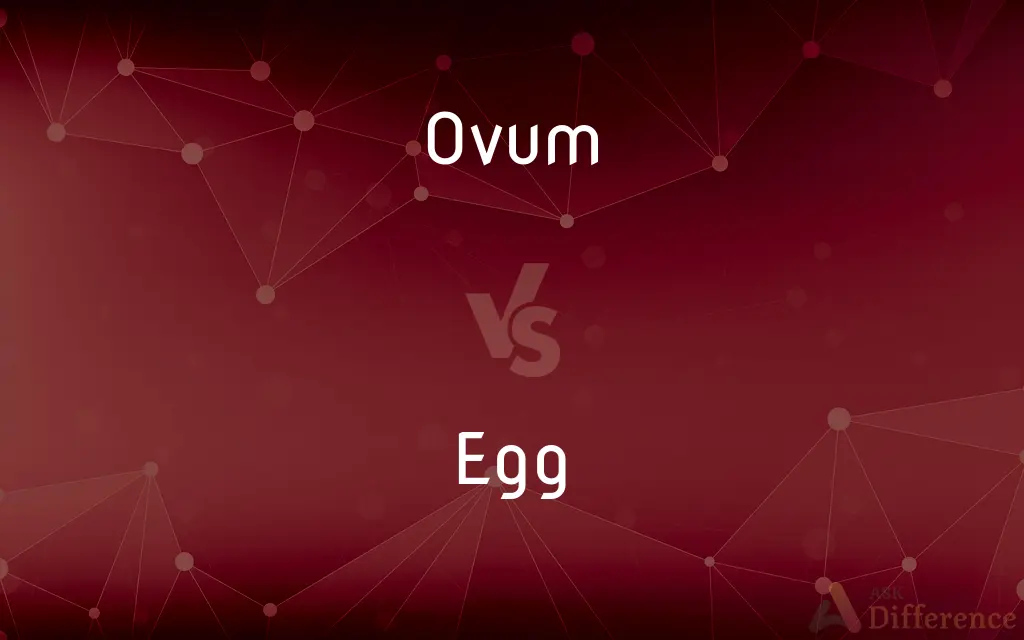Ovum vs. Egg — What's the Difference?
Edited by Tayyaba Rehman — By Urooj Arif — Updated on March 13, 2024
Ovum refers to the female gamete in animals, essential for reproduction, while Egg denotes a broader category, including the ovum and protective layers, often seen in birds and reptiles.

Difference Between Ovum and Egg
Table of Contents
ADVERTISEMENT
Key Differences
An ovum is the mature female reproductive cell, or gamete, in many multicellular organisms, playing a crucial role in reproduction by fusing with a sperm cell. In contrast, an egg is a more general term that can refer to the entire reproductive structure that contains the ovum, along with nutritive and protective layers, as seen in birds, reptiles, and some fish.
The ovum is typically a single cell, one of the largest in the female body, containing genetic material vital for the development of a new organism upon fertilization. Meanwhile, the egg, especially in birds and reptiles, includes not only the ovum but also additional layers like the albumen (egg white), shell membrane, and shell, providing protection and nutrients to the developing embryo.
In terms of size and visibility, an ovum is usually microscopic and not visible to the naked eye, reflecting its role as a single cell geared towards fusion with a sperm cell. On the other hand, an egg, such as a chicken egg, is much larger and designed to support the entire development process of the embryo outside the female body, making it visible and tangible.
The ovum's primary function is to carry half of the genetic material required to form a new organism and to possibly initiate the first steps of development after fertilization. The egg, with its additional structures, not only carries genetic material but also provides the necessary environmental conditions, such as protection, temperature regulation, and nutrition, for the embryo to develop until it can survive independently or until hatching.
The terms ovum and egg also differ in their application across species. "Ovum" is used specifically in the context of the female gametes in animals, including humans, whereas "egg" can refer to reproductive structures in a wide range of organisms, from animals to plants, fungi, and other groups, emphasizing its broader biological context and diversity of forms.
ADVERTISEMENT
Comparison Chart
Definition
The mature female gamete in animals.
The entire reproductive structure, including the ovum and additional layers, often seen in birds and reptiles.
Composition
A single cell containing half of the genetic material needed for reproduction.
Consists of the ovum and layers like the albumen, shell membrane, and shell, providing protection and nutrients.
Visibility
Microscopic, not visible to the naked eye.
Larger and visible, designed to support embryo development outside the female body.
Function
Carries genetic material and initiates development upon fertilization.
Carries genetic material and provides environmental conditions necessary for embryo development.
Application Across Species
Used specifically for female gametes in animals.
Used for reproductive structures in a wide range of organisms, from animals to plants and fungi.
Compare with Definitions
Ovum
The ovum is the female gamete involved in reproduction, containing half the genetic information necessary for the development of a new organism.
In humans, the ovum is fertilized by a sperm cell, leading to the development of an embryo.
Egg
An egg in biological terms refers to the entire reproductive package, including the ovum and supportive structures like the shell and albumen, found in birds and reptiles.
Chicken eggs, used commonly in cooking, consist of the shell, albumen, and yolk, which houses the ovum.
Ovum
Upon fertilization, the ovum completes its second meiotic division, contributing to the genetic diversity of the offspring.
The completion of meiosis in the ovum upon fertilization ensures the proper genetic makeup for development.
Egg
Eggs provide a protective environment for the developing embryo, safeguarding it from physical damage and providing necessary nutrients.
The hard shell of a bird's egg protects the embryo from external threats while allowing gas exchange.
Ovum
Ova are characterized by their large size relative to other cells, allowing them to store nutrients for the initial stages of embryonic development.
The human ovum, one of the largest cells in the body, facilitates early embryonic growth.
Egg
In many species, the egg is the means by which parents can ensure their offspring's development in a controlled environment outside their bodies.
Turtle eggs are buried in sand, where they incubate until hatching, independent of the mother's presence.
Ovum
The ovum's outer layer, the zona pellucida, plays a crucial role in sperm binding and fertilization.
The zona pellucida of an ovum contains receptors that are specific to sperm cells, ensuring successful fertilization.
Egg
The egg's composition and structure can vary widely among different species, adapted to the specific needs of the embryo and the environmental conditions.
Fish eggs are often surrounded by a jelly-like substance that provides additional protection in aquatic environments.
Ovum
The ovum's lifespan after ovulation is relatively short, necessitating fertilization within a specific timeframe for successful reproduction.
The human ovum must be fertilized within about 24 hours post-ovulation to ensure viability.
Egg
The size and number of eggs produced can relate to the reproductive strategy of the species, balancing between offspring quantity and parental investment.
Birds that lay fewer, larger eggs generally invest more parental care in each offspring compared to species that lay many small eggs.
Ovum
The mature female gamete of an animal; an egg.
Egg
An egg is the organic vessel containing the zygote in which an embryo develops until it can survive on its own, at which point the animal hatches. An egg results from fertilization of an egg cell.
Ovum
(cytology) The female gamete in animals; the egg cell.
Egg
A female gamete; an ovum. Also called egg cell.
Ovum
A more or less spherical and transparent cell, which by a process of multiplication and growth develops into a mass of cells, constituting a new individual like the parent; an egg, spore, germ, or germ cell. See Illust. of Mycropyle.
Egg
The round or oval female reproductive body of various animals, including birds, reptiles, amphibians, fishes, and insects, consisting usually of an embryo surrounded by nutrient material and a protective covering.
Ovum
One of the series of egg-shaped ornaments into which the ovolo is often carved.
Egg
The oval, thin-shelled reproductive body of a bird, especially that of a hen, used as food.
Ovum
The female reproductive cell; the female gamete
Egg
Something having the ovoid shape of an egg.
Egg
(Slang) A fellow; a person
He's a good egg.
Egg
To cover with beaten egg, as in cooking.
Egg
(Slang) To throw eggs at.
Egg
To encourage or incite to action. Used with on
The racing fans egged their favorites on.
Egg
An approximately spherical or ellipsoidal body produced by birds, insects, reptiles, and other animals, housing the embryo within a membrane or shell during its development.
Egg
Synonym of ovum; an egg cell.
Egg
(countable) A thing which looks like or is shaped like an egg (sense 1.1).
Egg
A swelling on one's head, usually large or noticeable, resulting from an injury.
Egg
(architectural element) Chiefly in egg and dart: an ornamental oval moulding alternating in a row with dart or triangular shapes.
Egg
A score of zero; specifically (cricket), a batter's failure to score; a duck egg or duck's egg.
Egg
A bomb or mine.
Egg
Senses relating to people.
Egg
(archaic) Something regarded as containing a (usually bad) thing at an early stage.
Egg
(computing) One of the blocks of data injected into a program's address space for use by certain forms of shellcode, such as "omelettes".
Egg
(transitive)
Egg
To throw (especially rotten) eggs (noun sense 1.1.1) at (someone or something).
The angry demonstrators egged the riot police.
The students were caught egging the principal’s car as a prank.
Egg
To inadvertently or intentionally distort (the circular cross-section of something, such as tube) to an elliptical or oval shape.
After I cut the tubing, I found that I had slightly egged it in the vise.
Egg
(cooking) To coat (a food ingredient) with or dip (a food ingredient) in beaten egg (noun sense 1.1.1) during the process of preparing a dish.
Egg
(intransitive) To collect the eggs (noun sense 1.1) of wild birds.
Egg
To encourage, incite, or urge (someone).
Egg
The oval or roundish body laid by domestic poultry and other birds, tortoises, etc. It consists of a yolk, usually surrounded by the "white" or albumen, and inclosed in a shell or strong membrane.
Egg
A simple cell, from the development of which the young of animals are formed; ovum; germ cell.
Egg
Anything resembling an egg in form.
Egg
To urge on; to instigate; to incite
Adam and Eve he egged to ill.
[She] did egg him on to tellHow fair she was.
Egg
Animal reproductive body consisting of an ovum or embryo together with nutritive and protective envelopes; especially the thin-shelled reproductive body laid by e.g. female birds
Egg
Oval reproductive body of a fowl (especially a hen) used as food
Egg
One of the two male reproductive glands that produce spermatozoa and secrete androgens;
She kicked him in the balls and got away
Egg
Throw eggs at
Egg
Coat with beaten egg;
Egg a schnitzel
Common Curiosities
What is the primary role of the ovum in reproduction?
The ovum provides half of the genetic material necessary for the formation of a new organism and initiates development upon fertilization.
What makes the ovum unique among other cells?
The ovum is one of the largest cells in the body, designed to store nutrients and genetic material necessary for the early stages of embryonic development.
Are all eggs visible to the naked eye?
While many eggs, like those of birds and reptiles, are visible and tangible, eggs of smaller organisms, like insects or fish, may be less visible.
Do all organisms produce eggs with hard shells?
No, the presence and nature of the eggshell vary widely among species; not all eggs have hard shells, as seen in mammals and many aquatic organisms.
Can an ovum be fertilized by more than one sperm?
Normally, an ovum is fertilized by a single sperm due to mechanisms like the cortical reaction that prevent polyspermy, ensuring proper genetic composition.
Why do eggs have different layers like the shell and albumen?
These layers provide mechanical protection, prevent desiccation, and offer nutritional and antimicrobial support to the developing embryo.
Why are bird eggs typically larger than those of many other animals?
Bird eggs are larger to accommodate all the nutrients and protective structures necessary for the embryo to develop outside the mother's body.
How does an egg support the development of an embryo?
An egg offers a protective environment, regulates temperature, and provides nutrients necessary for the embryo's development until it can survive independently or hatch.
Can the term "egg" be used for human reproductive cells?
In humans, the term "egg" colloquially refers to the ovum, but scientifically, "ovum" is more accurate for the female gamete.
Is the zona pellucida part of the egg or the ovum?
The zona pellucida is part of the ovum, serving as a protective glycoprotein layer that facilitates sperm binding and fertilization.
How long can an ovum survive after ovulation?
In humans, an ovum can survive approximately 12-24 hours post-ovulation, during which fertilization must occur for successful reproduction.
What determines the number of eggs an organism produces?
The number of eggs is influenced by the species' reproductive strategy, balancing between the quantity of offspring and the level of parental investment in each.
Are ovum and egg interchangeable terms in scientific contexts?
In scientific contexts, "ovum" refers specifically to the female gamete, while "egg" can refer to the ovum and its surrounding structures; the terms are not strictly interchangeable.
How do eggs facilitate gas exchange for the embryo?
Eggs, especially those with shells, have pores that allow for the exchange of gases like oxygen and carbon dioxide, crucial for embryonic respiration.
How do environmental conditions affect egg design and structure?
Egg design and structure are adapted to maximize survival and development based on specific environmental conditions, such as temperature, humidity, and predation risks.
Share Your Discovery

Previous Comparison
Ladder vs. Stair
Next Comparison
Ongoing vs. UndergoAuthor Spotlight
Written by
Urooj ArifUrooj is a skilled content writer at Ask Difference, known for her exceptional ability to simplify complex topics into engaging and informative content. With a passion for research and a flair for clear, concise writing, she consistently delivers articles that resonate with our diverse audience.
Edited by
Tayyaba RehmanTayyaba Rehman is a distinguished writer, currently serving as a primary contributor to askdifference.com. As a researcher in semantics and etymology, Tayyaba's passion for the complexity of languages and their distinctions has found a perfect home on the platform. Tayyaba delves into the intricacies of language, distinguishing between commonly confused words and phrases, thereby providing clarity for readers worldwide.














































